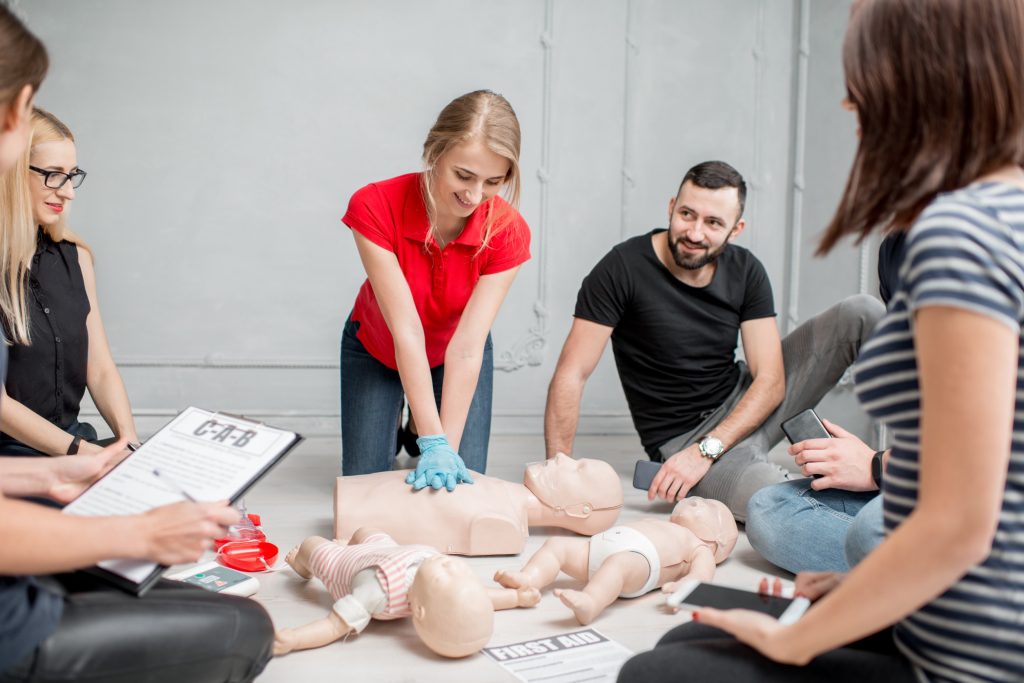CPR Classes Insurance, First Aid Instructors Insurance
In the United States, small businesses that provide CPR (Cardio-Pulmonary Resuscitation) classes and employ first aid instructors, while playing a vital role in equipping individuals with life-saving skills, face inherent risks and liabilities that necessitate the importance of CPR Classes Insurance. However, running such businesses comes with inherent risks and liabilities.
Need
CPR Classes Insurance ?
Get Your Free Quote
It is essential for these businesses and instructors to protect themselves financially and legally by obtaining appropriate insurance coverage.
In this article, we will delve into the significance of CPR classes insurance, explore insurance policies, benefits, and coverage, and provide insights on how to obtain online quotes specifically tailored to small businesses in the USA.

1. Understanding CPR Classes Insurance:
1.1 Importance of Insurance for CPR Classes Businesses:
- Role of CPR classes and first aid instructors in the community
- Risks and liabilities associated with running CPR classes businesses
- Financial and legal protection through insurance coverage
1.2 Types of Insurance Policies for CPR Classes Businesses:
- General Liability Insurance:
- Coverage for bodily injury or property damage claims
- Protection against third-party lawsuits
- Professional Liability Insurance (Errors and Omissions Insurance):
- Coverage for claims of professional negligence or inadequate instruction
- Defense costs and settlements
- Property Insurance:
- Coverage for business property, equipment, and supplies
- Protection against damage or loss due to fire, theft, or natural disasters
- Business Interruption Insurance:
- Coverage for lost income and operating expenses during temporary closures
- Protection against financial hardships caused by unforeseen events
2. Insurance Benefits for CPR Classes Businesses and First Aid Instructors:
2.1 Financial Protection:
- Coverage for legal expenses, settlements, and judgments in liability claims
- Compensation for property damage, loss, or theft
- Reimbursement for income loss during business interruption
2.2 Peace of Mind:
- Confidence in knowing that potential risks and liabilities are mitigated
- Focus on providing quality CPR classes and instruction without constant worry
- Assurance that financial stability is safeguarded against unforeseen circumstances

3. Insurance Coverage Details for CPR Classes Businesses:
3.1 General Liability Insurance Coverage:
- Bodily injury coverage for accidents during CPR classes
- Property damage coverage for incidents on the business premises
3.2 Professional Liability Insurance Coverage:
- Protection against claims of professional negligence or inadequate instruction
- Coverage for legal defense costs and settlements
- Tailored coverage for specific risks faced by first aid instructors
3.3 Property Insurance Coverage:
- Protection for the business property, equipment, and supplies
- Coverage for damage or loss caused by fire, theft, vandalism, or natural disasters
3.4 Business Interruption Insurance Coverage:
- Compensation for lost income and operating expenses during business closures
- Coverage for temporary relocation costs and additional expenses incurred
4. How to Get Online Quotes for CPR Classes Insurance:
4.1 Researching Insurance Providers:
- Importance of selecting reputable insurance companies
- Evaluating the experience and expertise in providing coverage for CPR classes businesses
- Checking customer reviews and ratings for reliable insurance providers
4.2 Gathering Information for Online Quotes:
- Business details: Name, address, entity type, years in operation
- Description of services offered: CPR classes, first aid instruction, additional training programs
- Employee details: Number of instructors, their qualifications, and experience
- Coverage requirements: Liability limits, desired policy features
4.3 Obtaining Online Quotes:
- Utilizing insurance provider websites with online quote tools
- Inputting accurate and detailed information for accurate quotes
4.4 Comparing Quotes and Coverage Options:
- Reviewing the obtained quotes and comparing coverage options
- Assessing the policy limits, deductibles, and exclusions
- Considering additional endorsements or specialized coverage for specific risks
4.5 Seeking Professional Guidance:
- Consulting with insurance agents or brokers specializing in small business insurance
- Seeking expert advice on coverage needs, policy options, and pricing
- Clarifying any doubts or questions regarding the insurance policies
FAQ for First Aid Instructor Insurance
What are CPR Classes?
CPR classes, formally known as Cardio-Pulmonary Resuscitation classes, encompass educational programs tailored to equip individuals with the knowledge and skills necessary to effectively respond to cardiac emergencies.
The primary objective of CPR is to administer timely and proficient assistance to individuals experiencing sudden cardiac arrest or cessation of breathing. By engaging in these classes, participants acquire the essential proficiency required to navigate such critical situations.
CPR classes typically encompass comprehensive instruction on crucial aspects, including the prompt recognition of cardiac arrest, the correct execution of chest compressions, the administration of rescue breaths, and the proper utilization of automated external defibrillators (AEDs), if available.
Small Business General Liability Protection:
Get Your Free Quote
Organizations such as the American Heart Association (AHA) and the Red Cross are renowned for their provision of CPR training.
The acquisition of CPR techniques empowers individuals with the ability to respond swiftly and efficiently during emergencies, thereby augmenting the potential for saving lives. These classes cater to a diverse range of individuals, including healthcare professionals, lifeguards, educators, parents, and any individual desiring to obtain invaluable life-saving competencies.
By adopting a unique and formal tone, the significance and gravity of CPR classes are effectively conveyed, underscoring the pivotal role they play in equipping individuals with the ability to act decisively and effectively in dire circumstances.
What is the Diversity of CPR Class Types Coverage?
CPR classes come in various forms to cater to different needs and scenarios. From online sessions like Zoom Meetings to specialized coverage for specific professions like X-ray Technicians, there is a wide range of options available.
Whether you prefer weekend classes, require coverage as a Registered Nurse or Nurse Instructor, or are seeking training for unique situations like Quinceanera or Child and Infant CPR, there is a class type designed to meet your requirements.
With coverage options extending to various individuals, such as Family Members, Employees, and even Dogs, CPR classes provide comprehensive training and liability protection for diverse scenarios.
How can CPR Classes Insurance benefit first aid instructors?
CPR Classes Insurance benefits first aid instructors by providing protection against potential lawsuits, helping to preserve their professional reputation, and ensuring financial stability. It allows them to focus on delivering high-quality training without the constant worry of legal and financial consequences.
Get Your Business Insurance:
Get Your Free Quote
What does Professional Liability Insurance cover for first aid instructors?
Professional Liability Insurance, also known as Errors and Omissions Insurance, covers claims of professional negligence or inadequate instruction. If a participant alleges that they were harmed due to the instructor’s negligence or lack of proper training, this insurance provides coverage for legal defense costs and potential settlements.
What’s the Difference Between First Aid Trainer and Instructor Insurance?
First aid instructor insurance and first aid trainer insurance generally refer to similar insurance policies designed to protect professionals who teach first aid skills. They both typically cover liabilities that may arise during training.
First aid liability insurance is a broader term that covers potential claims against first aid training activities. On the other hand, professional indemnity insurance for first aid trainers specifically protects against claims of professional negligence or misadvice. When obtaining CPR training quotes, it’s essential to consider the specific risks involved in your training scenarios, the coverage extent of the policy, and the premium costs.
What Are the Different Services Offered by First Aid Instructors?
First Aid Instructors provide a range of essential services, catering to various needs and scenarios. Here’s an overview of the different types of services typically offered:
- Basic First Aid Training: This fundamental course covers common medical emergencies, basic treatment procedures, and general health and safety practices. It’s suitable for the general public, including workplaces, schools, and community groups.
- Advanced First Aid Training: Designed for individuals who require more in-depth knowledge, such as outdoor guides or sports coaches, this training covers advanced techniques and complex scenarios.
- CPR Training: Focused on cardiopulmonary resuscitation techniques, these courses teach participants how to respond to cardiac and breathing emergencies in adults, children, and infants.
- Automated External Defibrillator (AED) Training: This training integrates the use of AEDs with CPR techniques, vital for responding to sudden cardiac arrest scenarios.
- Pediatric First Aid: Specifically tailored for those working with children, such as teachers and childcare providers, these courses cover first aid techniques applicable to infants and children.
- First Aid at Work: Customized for workplace settings, these courses address workplace-specific risks and comply with occupational health and safety regulations.
- Outdoor and Wilderness First Aid: Ideal for adventure enthusiasts, outdoor instructors, and guides, these courses focus on first aid techniques in remote environments where medical help is not readily available.
- Mental Health First Aid: These courses educate individuals on how to assist someone experiencing a mental health crisis or developing a mental health problem.
- First Aid for Sports Injuries: Geared towards coaches, trainers, and athletes, these courses cover common sports-related injuries and prevention strategies.
- Customized First Aid Training: Many instructors offer customized courses tailored to the specific needs of a group or organization, addressing unique risks and scenarios relevant to them.
Each of these services plays a vital role in ensuring public safety and preparedness for emergencies. First Aid Instructors must stay updated with the latest medical guidelines and training methodologies to provide effective and accurate training.
How Do Various Risks Impact CPR Classes and First Aid Instructor Businesses?
Before diving into the specifics of the risks associated with CPR classes and First Aid Instructor businesses, it’s important to understand that these fields, while incredibly valuable in terms of health education and emergency preparedness, come with their own set of unique challenges.
Get Your Business Insurance:
Get Your Free Quote
From physical injuries during practical training sessions to legal liabilities stemming from accidents or non-compliance with regulatory standards, the potential risks are diverse.
These risks not only pose threats to the safety and well-being of both instructors and students but also impact the financial and operational aspects of the business. Understanding these risks is crucial for effective management and mitigation strategies. The following table provides an overview of the key risk categories and their potential impacts on CPR and First Aid training businesses.
| Risk Category | Potential Risks | Brief Description |
|---|---|---|
| Physical Injuries | – Injuries to students or instructors – Injuries due to improper use of equipment |
Physical harm that can occur during practical training sessions, especially if safety protocols are not followed. |
| Health Risks | – Risk of transmitting infectious diseases – Health complications during training |
Potential for spreading illnesses, especially during mouth-to-mouth resuscitation or close physical contact. |
| Legal Liabilities | – Lawsuits due to injuries or accidents – Non-compliance with regulatory standards |
Legal actions that can arise from accidents or failure to adhere to industry regulations and standards. |
| Property Damages | – Damage to training facilities or equipment | Financial losses due to damage of property used during training sessions. |
| Professional Liabilities | – Misinformation or incorrect training – Professional indemnity issues |
Risks associated with providing incorrect guidance or training, leading to potential mishandling of real-life situations. |
| Financial Risks | – Business interruptions – Costs associated with insurance, certifications, and equipment maintenance |
Financial challenges related to running the business, including potential disruptions and ongoing costs. |
This table is not exhaustive and should be used as a starting point for a more detailed risk assessment. Each business may face unique challenges and should consult with professionals for a comprehensive analysis.

Final Thought for First Aid Instructors Insurance
CPR classes businesses and first aid instructors in the USA play a critical role in equipping individuals with life-saving skills. However, they face various risks and liabilities in their day-to-day operations.
Acquiring appropriate insurance coverage is vital for these small businesses to protect themselves financially and legally.
By understanding the importance of insurance for CPR classes businesses, exploring various insurance policies and their benefits, and comprehending the coverage details, these businesses can make informed decisions about obtaining the right insurance coverage.
Furthermore, obtaining online quotes tailored to small businesses in the USA allows for convenient comparison of coverage options and pricing.
By conducting thorough research, gathering accurate information, and seeking professional guidance, CPR classes businesses and first aid instructors can secure the most suitable insurance coverage that provides financial protection, peace of mind, and a solid foundation for their operations.
Remember, insurance is not just a mere expense but an investment in the longevity and stability of CPR classes businesses.
With the right insurance coverage, these small businesses can continue to thrive, positively impact their communities, and provide essential life-saving training to individuals across the nation.

